Key takeaways
In this article…
What is the employee life cycle?
The employee life cycle provides a concrete framework for conceptualizing each part of the employee journey, from brand awareness to offboarding. It consists of six stages an employee experiences before, during, and after their employment, including:
The employee life cycle is both continuously flowing and non-linear. Employees constantly enter and exit stages based on work needs, professional goals, and current workplace trends.
At the same time, employees may skip, oscillate between, or co-exist in stages depending on their particular path. For example, employees may enter the retention and development stages multiple times throughout their tenure as they advance in the company.
Human resources (HR) departments’ direct involvement in each stage makes them the key players in monitoring their organization’s employee life cycle. With their help, your company can identify opportunities to improve the cycle and create more efficient processes, happier employees, and a positive company culture.
What are the stages of the employee life cycle?
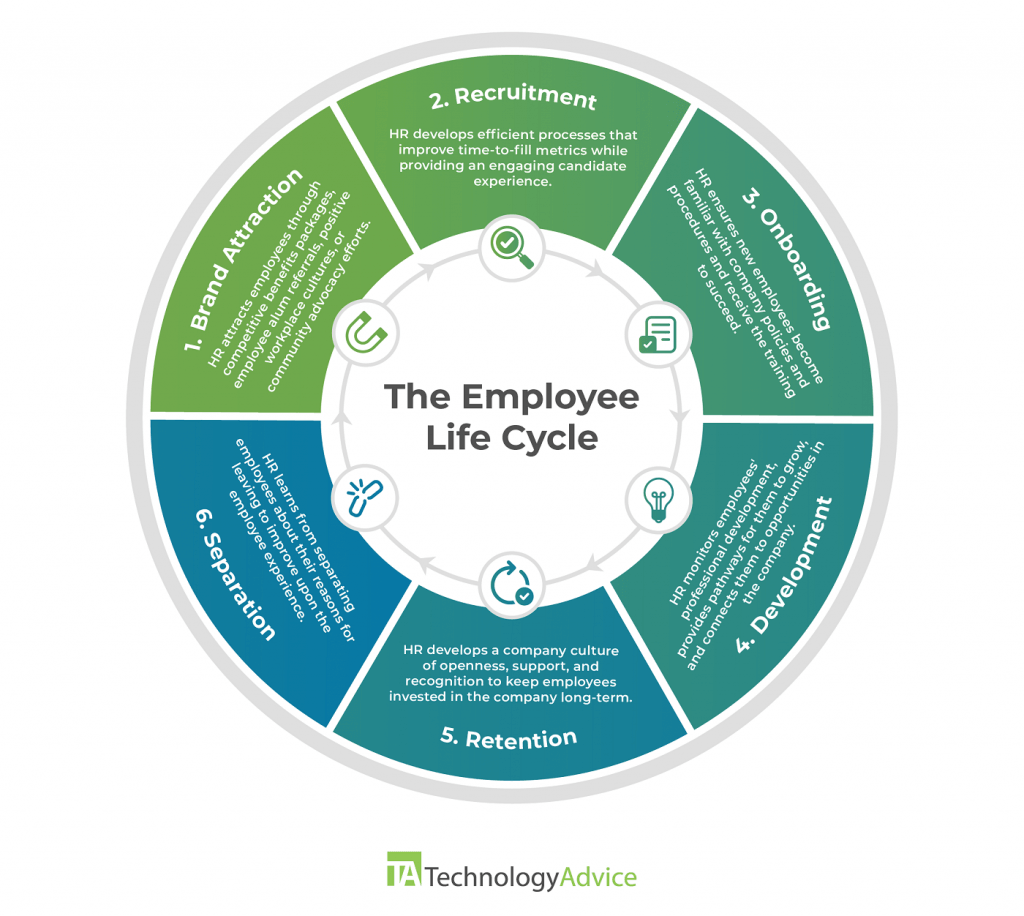
Brand attraction
Brand attraction refers to a potential candidate’s first impression of a company or brand. It encompasses any other touchpoints between initial brand awareness and becoming aware of a job opening. In some cases, there may be no lag time at all, while in other situations a candidate may be aware of the company for months or years before applying to a job.
HR’s role in brand attraction
Brand attraction is an opportunity for HR teams to collaborate with marketing teams to ensure any and all marketing messages align with recruitment materials. Together, both teams can work to create positive impressions of the company, stand out from competitors, and leverage marketing software effectively.
HR professionals can also influence brand attraction in less direct ways, such as:
Candidate relationship management software that markets to passive candidates offers great tools for enhancing your employer brand. Beamery, for instance, allows you to create customized career sites to advertise your open positions alongside other company marketing content.
Learn more about the Beamery platform:
Recruitment
Recruitment refers to the job application and hiring process. It starts when a company posts a job opening and continues through the application and interview process. The recruitment phase ends when a candidate receives (and accepts) a final offer letter. This stage can cover many different activities, from asking for referrals to implementing an applicant tracking system (ATS) to find qualified candidates.
HR’s role in recruitment
Depending on the company, either HR teams or external recruiting agencies may handle the recruitment phase. Some companies also split the recruitment process between internal and external teams. For instance, a recruiting agency might handle sourcing candidates and setting up initial screening, while the internal team takes care of the final interview and officially extends the offer letter.
Even if splitting duties between internal and external teams, HR departments should be aware of the compliance aspect of the recruitment process. For example, they are responsible for legally sound job descriptions and training managers on proper interview techniques that limit implicit biases.Recruitment software can also improve the effectiveness and efficiency of this stage by tracking candidate applications and other recruitment metrics. Zoho Recruit, for example, lets you send automated emails to candidates throughout the hiring process to keep them engaged and invested.
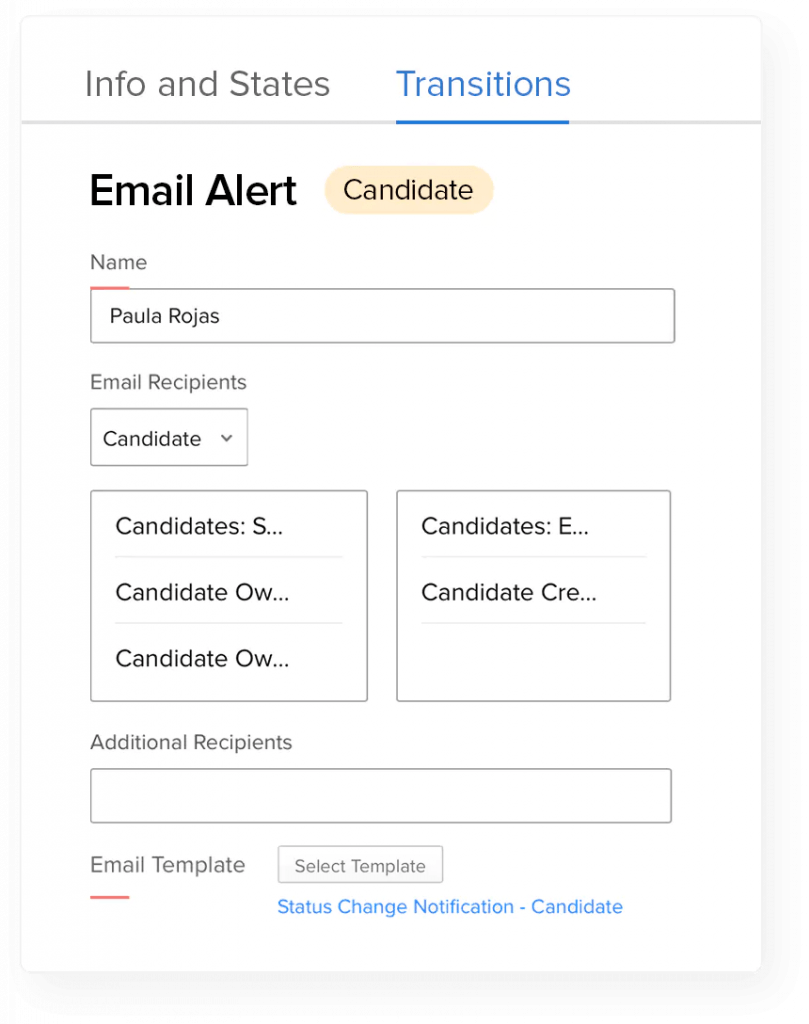
Onboarding
Onboarding refers to the process of integrating a newly hired employee into the company. It covers preboarding, any initial training period, and the payroll and benefits enrollment process. Onboarding is a crucial stage for getting employees up to speed about the specifics of their jobs as well as company culture and values.
HR’s role in onboarding
While the new hire’s supervisor will also be involved in this process, HR teams play a big role in employee onboarding. They ensure new employees complete necessary paperwork, like I-9 forms or W-4s, provide job-specific training through learning management systems, and educate new hires about company policies and procedures.Onboarding software, especially ones that integrate with your ATS or HR software, can help improve the efficiency of this phase by offloading the tedious, repetitive portions through automation. For example, GoCo offers a Workflow Builder that connects all onboarding stakeholders, like IT, HR managers, and direct managers, without the need to reach out to them manually.
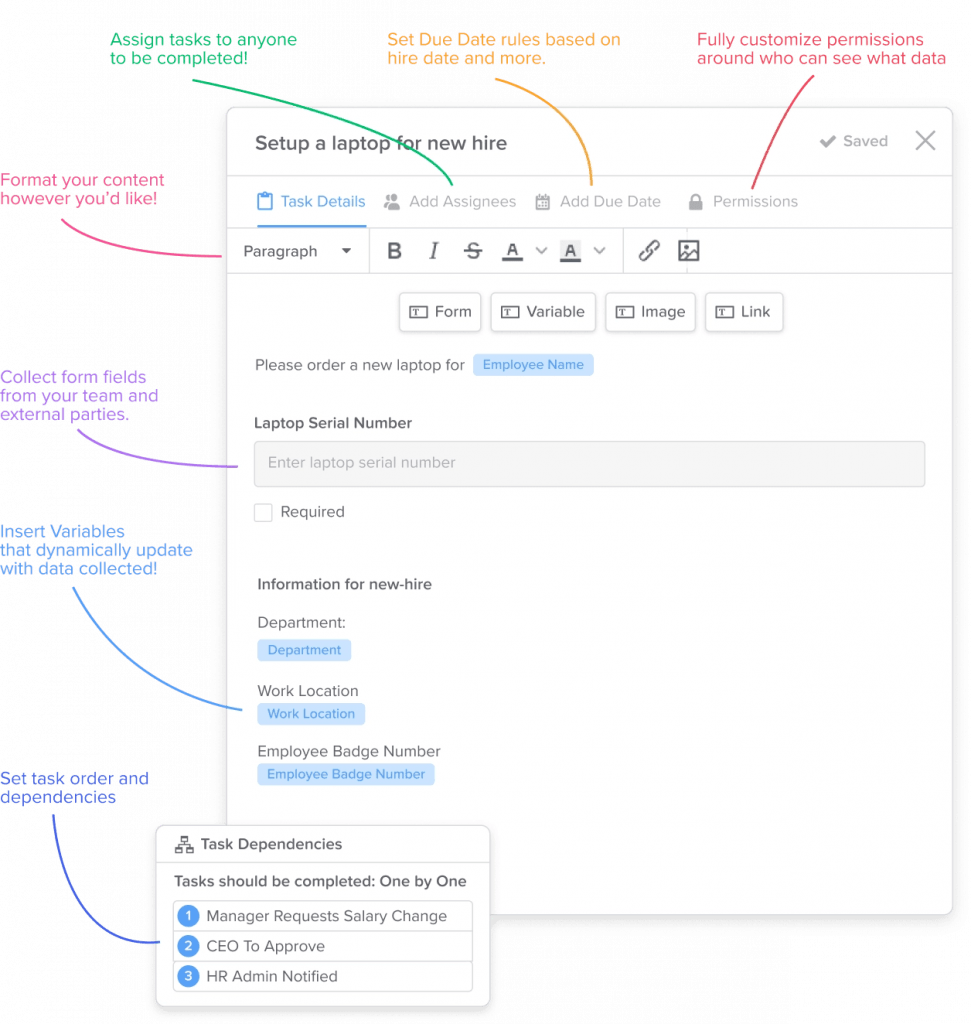
Development
Development refers to various activities that relate to helping employees build their skills and knowledge. These activities can range from sending them to conferences to conducting performance reviews. Professional development is often closely tied to promotions and pay bumps, as well as preparing employees to take on more responsibility.
HR’s role in development
HR teams can do many things to provide professional development for both managers and employees, like implementing a performance management program and creating a formal review process. Beyond these, they are also instrumental in aligning employees’ interests with bigger-picture company objectives through processes like:
You may consider using performance measurement software, like Lattice, or learning management systems (LMSs), like Docebo, to simplify these processes and provide employees with some control over their journeys.
Learn more about the importance of performance management for supporting employees’ professional futures and company innovation.
Retention
Retention refers to various activities that help keep existing employees challenged and motivated, including pay increases, promotions, team-building events, and more. It also involves collecting employee feedback about areas where the company could improve and making meaningful changes based on that feedback.
HR’s role in retention
The employee’s team and direct supervisor play a major role in the retention stage, but HR teams also have an important part to play. While managers are typically more concerned with individual employees, HR teams take a strategic approach from a higher level.
To do this, HR teams can take a few approaches:
Employment engagement and rewards software can help you facilitate these processes by gathering employee feedback and providing channels for engagement. For instance, Motivosity offers pulse surveys for insight into employee sentiment and options like awards, achievements, or gift cards to keep employees motivated in their work.
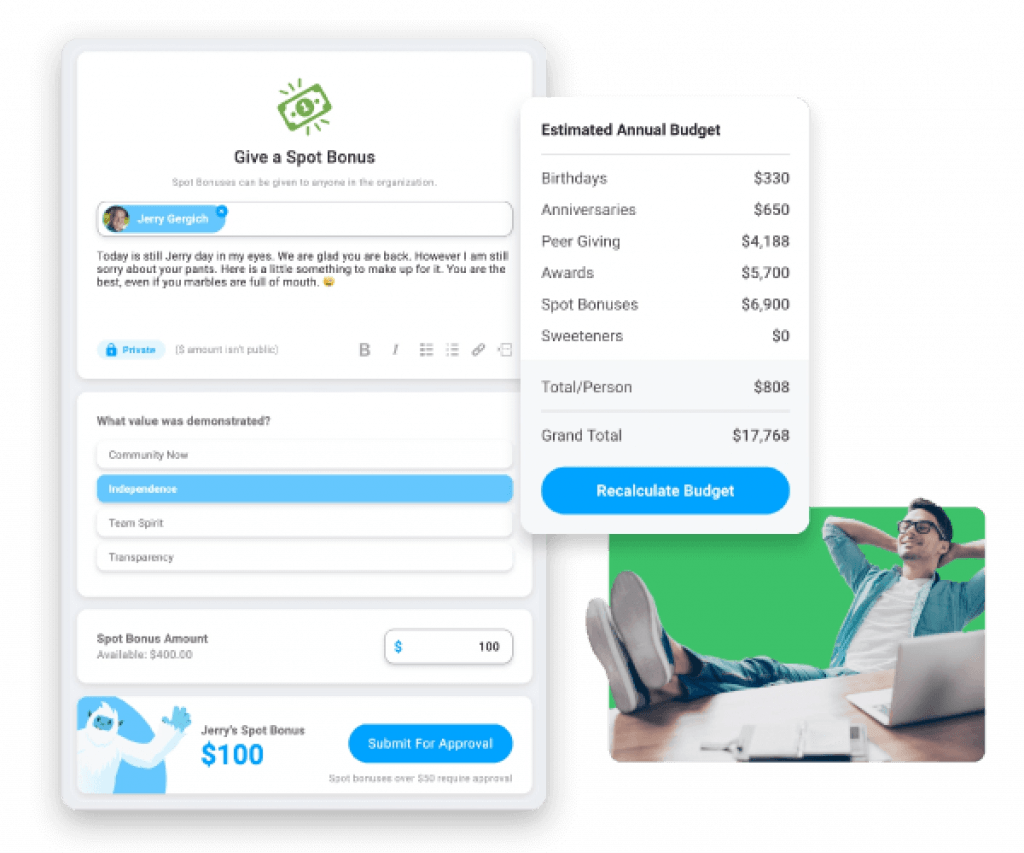
Separation
Separation refers to the offboarding procedures for an employee who has been terminated, whether voluntarily or involuntarily. While this is usually the shortest of all the stages of the employee life cycle, it’s no less important.
Typical reasons for voluntary separation include employees quitting for another job, personal reasons, or retirement. Meanwhile, reasons for involuntary separation usually include discharges for cause or layoffs.
HR’s role in separation
During the separation phase, HR teams should verify all offboarding documentation is thoroughly completed and in line with federal and state regulations. This includes information about final paychecks, severance agreements, benefits continuation, and other separation requirements.
If the employee leaves voluntarily, an HR staff member should also conduct an exit interview to understand why. These discussions can provide valuable insights into people analytics like attrition, employee turnover, and employee net promoter score (eNPS). BambooHR, for example, includes an entire offboarding module to promote consistent exit practices and uncover trends affecting these numbers.Handling this stage well is vital for continuing the employee life cycle. For instance, happy alumni may return as boomerang employees or refer the next generation of talent, restarting the employee life cycle anew.
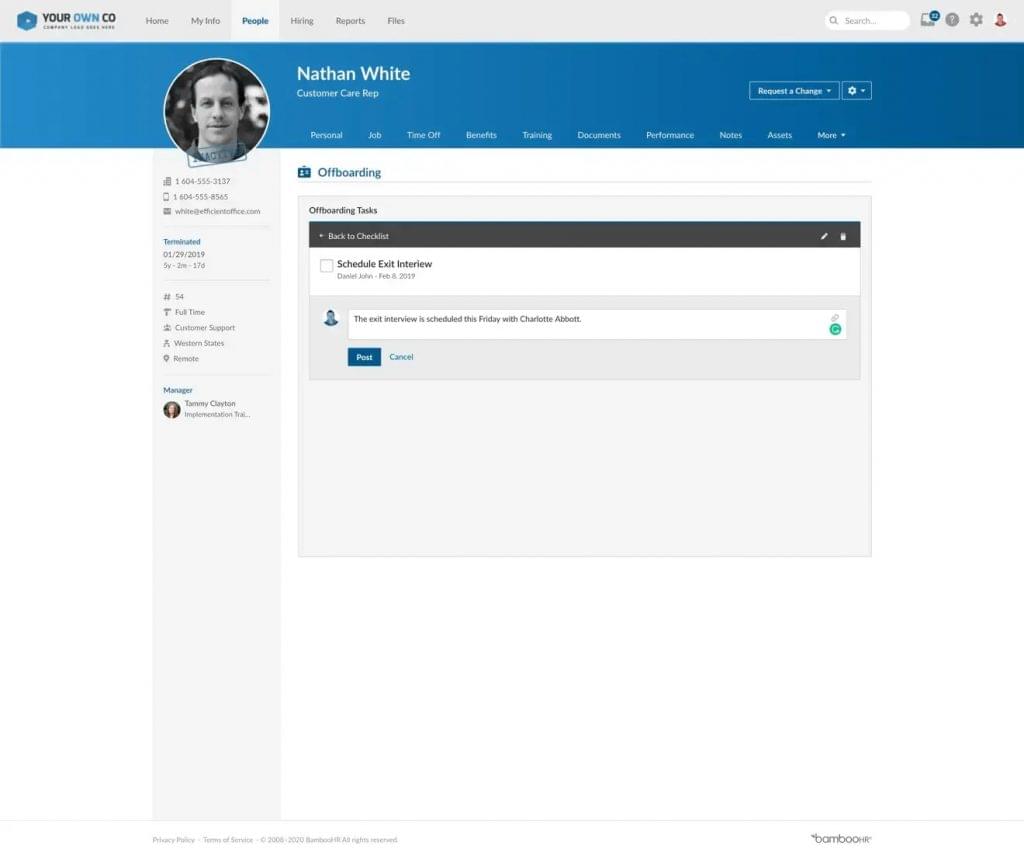
Why is the employee life cycle important?
With successful employee life cycle management, your company can:
Maintaining a healthy employee life cycle is also crucial for facilitating a constant flow of new ideas to help your company innovate and grow. To track this health, you can use specific HR metrics in each stage like:
Analyzing these metrics allows your HR teams to see employee priorities holistically. All too often, HR teams could have prevented or addressed employee burnout, disengagement, and performance issues if the right life cycle measures were in place. Instead, using these data points ensures employees receive consistent care and attention while reacting quickly to any signs of slowing growth.
How technology can improve the employee life cycle
Leveraging technology, like full-scale HR software, helps HR teams monitor the entire employee life cycle at a glance for more strategic planning, proactive problem-solving, and data-driven decision-making.
For instance, you can take advantage of software that targets specific areas of the life cycle where you need assistance the most, such as:
Depending on your company’s needs, you may want separate, specialized platforms in each stage for a more customized experience. Alternatively, you may choose all-in-one solutions, like human resources information systems (HRISs), human resources management systems (HRMSs), or human capital management (HCM) platforms, to provide a holistic view of the life cycle and a less disparate tech stack.
By using these tools, you can optimize every stage of the employee life cycle to attract, hire, develop, and retain valuable and engaged employees, ensuring your business’s long-term success.
About the author


